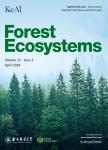Addressing nonresponse bias in forest inventory change estimation using response homogeneity classifications
Addressing nonresponse bias in forest inventory change estimation using response homogeneity classifications作者机构:U.S.Forest ServiceNorthern Research StationYorkPAUSA U.S.Forest ServiceNorthern Research StationSt.PaulMNUSA
出 版 物:《Forest Ecosystems》 (森林生态系统(英文版))
年 卷 期:2023年第10卷第1期
页 面:125-131页
核心收录:
学科分类:0710[理学-生物学] 0830[工学-环境科学与工程(可授工学、理学、农学学位)] 0907[农学-林学] 08[工学] 0829[工学-林业工程] 09[农学] 0901[农学-作物学] 0833[工学-城乡规划学] 0713[理学-生态学] 0834[工学-风景园林学(可授工学、农学学位)]
主 题:Disturbance Post-stratification Land use conversion Sample bias
摘 要:Estimating amounts of change in forest resources over time is a key function of most national forest inventories(NFI). As this information is used broadly for many management and policy purposes, it is imperative that accurate estimations are made from the survey sample. Robust sampling designs are often used to help ensure representation of the population, but often the full sample is unrealized due to hazardous conditions or possibly lack of land access permission. Potentially, bias may be imparted to the sample if the nonresponse is nonrandom with respect to forest characteristics, which becomes more difficult to assess for change estimation methods that require measurements of the same sample plots at two points in time, i.e., remeasurement. To examine potential nonresponse bias in change estimates, two synthetic populations were constructed: 1) a typical NFI population consisting of both forest and nonforest plots, and 2) a population that mimics a large catastrophic disturbance event within a forested population. Comparisons of estimates under various nonresponse scenarios were made using a standard implementation of post-stratified estimation as well as an alternative approach that groups plots having similar response probabilities(response homogeneity). When using the post-stratified estimators, the amount of change was overestimated for the NFI population and was underestimated for the disturbance population, whereas the response homogeneity approach produced nearly unbiased estimates under the assumption of equal response probability within groups. These outcomes suggest that formal strategies may be needed to obtain accurate change estimates in the presence of nonrandom nonresponse.



